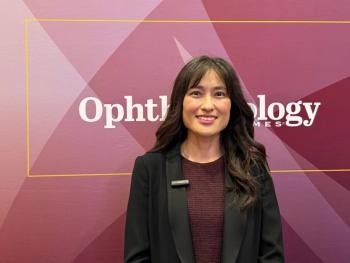
- Ophthalmology Times: May 2023
- Volume 48
- Issue 5
Teprotumumab: First FDA-approved treatment for TED
Treatment option offers positive outcome for patients diagnosed with disease.
Reviewed by Madhura A. Tamhankar, MD
The results of a real-world treatment for patients with thyroid eye disease (TED) who also have dysthyroid optic neuropathy (DON) indicated that teprotumumab-trbw (Tepezza, Horizon Therapeutics) infusion was effective for managing DON, according to Madhura A. Tamhankar, MD. Tamhankar presented the findings at the 2023 North American Neuro-Ophthalmology Society Annual Meeting in March.
Teprotumumab is the first medicine approved by the FDA to treat patients with TED, which is a serious, progressive and potentially vision-threatening rare autoimmune disease. DON is a serious complication of TED characterized by thyroid-related impairment of visual function that can lead to permanent vision loss related to optic nerve compression, according to Tamhankar, an associate professor of ophthalmology and neurology at the Hospital of the University of Pennsylvania in Philadelphia. Most of the patients treated with teprotumumab in the study under discussion had not responded to other treatments such as oral or intravenous steroids, radiation, and/or surgery.
Results of a study that assessed the effects of TED were recently published in JAMA Ophthalmology.1 The authors reported that patients with moderate to severe disease experience substantial disability in their day-to-day lives. In the study of more than 100 participants, the worst impact on quality of life was associated with the most severe disease state (constant diplopia and large proptosis).
TED results
In a meta-analysis of published reports, including the authors’ experience, 24 patients with TED (13 women; mean age, 66 years), 36 eyes of which had DON, were treated with teprotumumab between January 2020 and September 2022 in multiple centers in the US. The disease duration among these patients ranged from 2 to 15 years.
Tamhankar reported that after teprotumumab infusion treatment, the visual acuity improved in most eyes with DON, with a mean increase of 3.7 lines of vision in 23 patients. There was a mean improvement in the deviation on visual field testing of –5.87 decibels in 7 patients, a mean decrease in proptosis of 4.4 mm in 19 patients, a mean improvement in diplopia of 0.75 grade in 8 patients, and a mean reduction in the Clinical Activity Score of 5.1 in 17 patients.
None of the patients had succeeded with previous treatments of steroids, radiation, and surgery. Following teprotumumab, the DON improved in 19 of 22 patients.
Three patients had longstanding DON with poor vision and optic atrophy and did not show improvement. In 2 cases, teprotumumab was given as monotherapy, which led to complete resolution of DON.
Other noteworthy findings were that 88% of patients noted improvement after 3 infusions of teprotumumab. The imaging data from 9 patients showed reduction in the extraocular muscle volume and decompression of the orbital apex before and after infusion. In addition, the improvements in proptosis seen in 29 eyes with DON did not occur in association with surgery.
Ten patients were followed at an average of 23 weeks, and the improvements in DON were sustained in 88%. TED recurred in 3 patients. The adverse events of teprotumumab included fatigue, dysgeusia, hearing issues, nausea, hyperglycemia, and muscle spasms. These were well tolerated in all but 1 patient.
“We know how devastating TED can be for patients, and the risk of blindness in those with DON is one of the most worrisome complications, especially when traditional therapies fail,” Tamhankar explained. “These data are encouraging for physicians looking for an option to treat patients at the highest risk of losing their sight and provide evidence that teprotumumab can help improve symptoms and preserve visual acuity.”
The take-home messages regarding teprotumumab are that the drug is effective for managing DON in most patients in whom the conventional therapies such as steroids, orbital radiation, and orbital decompression caused minimal to no improvement or progressive visual loss; the improvement in vision was sustained in most patients after the teprotumumab infusions were completed; and the 2 patients who received teprotumumab as the first-line therapy had complete and sustained improvement in DON.
Madhura A. Tamhankar, MD
E: [email protected]
Dr Tamhankar is a consultant to Horizon Therapeutics.
Reference
1. Smith TJ, Cockerham K, Lelli G, et al. Utility assessment of moderate to severe thyroid eye disease health states. JAMA Ophthalmol. Published online December 29, 2022. doi:10.1001/jamaophthalmol.2022.3225
Articles in this issue
over 2 years ago
Building a successful cross-linking practiceover 2 years ago
Preservative-free latanoprost vs BAK-preserved latanoprostover 2 years ago
Peptide therapeutics are being introduced into ophthalmologyover 2 years ago
Understanding options for combination myopia managementover 2 years ago
Expert sheds light on treating EBMD and recurrent erosionsover 2 years ago
Lessons from the Togo Glaucoma Projectover 2 years ago
New approach to foveal holes: Light, sound, and nutraceuticalsover 2 years ago
How decreased cone densities may help detect and monitor MSover 2 years ago
Taking the long view of managing myopiaNewsletter
Don’t miss out—get Ophthalmology Times updates on the latest clinical advancements and expert interviews, straight to your inbox.



















































.png)


